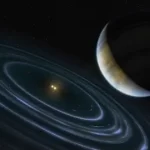Key Takeaways:
- NASA’s TESS (Transiting Exoplanet Survey Satellite) has identified a potentially habitable Earth-sized planet, TOI-700 d, within the habitable zone of its host star, TOI-700, located 100 light-years away in the Dorado constellation.
- TOI-700 d is the first Earth-sized habitable-zone planet discovered by TESS and orbits its host star every 37 days. The proximity of TOI-700 d to Earth and its habitable conditions make it an exciting target for further observation using the James Webb Space Telescope and ground-based telescopes.
- Liquid water is crucial for habitability, as it provides a medium for chemical interactions necessary for life. TESS has focused on stars bright enough for follow-up observations, discovering over 1,500 planet candidates, with TOI-700 d being the first Earth-sized planet within its star’s habitable zone.
- The TOI-700 system consists of three planets: TOI-700 b, c, and d. Planet d, being Earth-sized and within the habitable zone, holds promise for potential habitability. However, climate simulations suggest that an Earth-like atmosphere and gas pressure may not be sufficient to support liquid water on TOI-700 d’s surface.
- The discovery marks a transition in exoplanetary research from identification to characterization of atmospheres. Observations with the James Webb Space Telescope aim to confirm hypotheses about TOI-700 d’s atmosphere and explore the potential habitability of planets around small, dim stars like TOI-700.
Astronomers from NASA’s TESS project have unveiled a groundbreaking discovery: an Earth-sized planet, TOI-700 d, nestled within the habitable zone of its host star, TOI-700, located approximately 100 light-years away in the Dorado constellation.
This revelation stems from the collaborative efforts of NASA exoplanet astronomers, including Josh Schlieder and his team, who analyzed data from TESS (Transiting Exoplanet Survey Satellite). The newfound planet’s proximity to Earth and potential habitability have sparked significant interest within the scientific community.
TOI-700, also known as TESS of Interest number 700, is a diminutive, dim star, merely 40% the size of our Sun and 1/50th as bright. It stands at a distance of 100 light-years, making it visible from the Southern Hemisphere in the constellation Dorado. The star hosts three planets: b, c, and d. Notably, Planet d, being Earth-sized, orbits within the habitable zone every 37 days, making it a prime candidate for further observation.
The pursuit of habitable exoplanets gains momentum with TOI-700 d’s discovery, especially considering its accessibility for potential atmospheric studies using instruments like the James Webb Space Telescope. The significance lies in the potential to detect bio-signatures, indicative of habitable conditions, and even potential signs of extraterrestrial life.
TESS, in its mission to explore planets around the Sun’s nearest neighbors, has identified over 1,500 planet candidates since April 2018. The majority of these candidates, however, are larger than Earth and orbit too closely to their host stars, rendering them inhospitable for liquid water. The importance of liquid water for habitability cannot be overstated, as it provides a medium for essential chemical interactions conducive to life.
TOI-700 d’s habitable status was confirmed through independent observations by Joey Rodriguez and his team at the Center for Astrophysics at Harvard University, utilizing the Spitzer telescope. This collaboration eliminated doubts regarding the planet’s authenticity, paving the way for further investigations into its climate and potential habitability.

To unravel the mysteries of TOI-700 d, climate modeling was employed by researchers, including Ravi Kumar Kopparapu, a NASA Research Scientist of Planetary Studies. The simulations explored various atmospheric compositions, including those resembling Earth’s current atmosphere, Earth’s ancient atmosphere 2.7 billion years ago, and even a Martian-like atmosphere from 3.5 billion years ago.
Surprisingly, the climate simulations revealed that an Earth-like atmosphere and gas pressure alone might not be sufficient to support liquid water on TOI-700 d’s surface. Despite the challenges, scientists remain optimistic, emphasizing the uniqueness of planets around small, dim stars like TOI-700 and the need to explore new techniques for characterizing their atmospheres.
In the evolving field of exoplanetary research, the discovery of TOI-700 d marks a crucial step towards transitioning from identification to the detailed characterization of atmospheres. The James Webb Space Telescope, offering a glimpse into the climates of distant worlds and their potential to harbor life.


